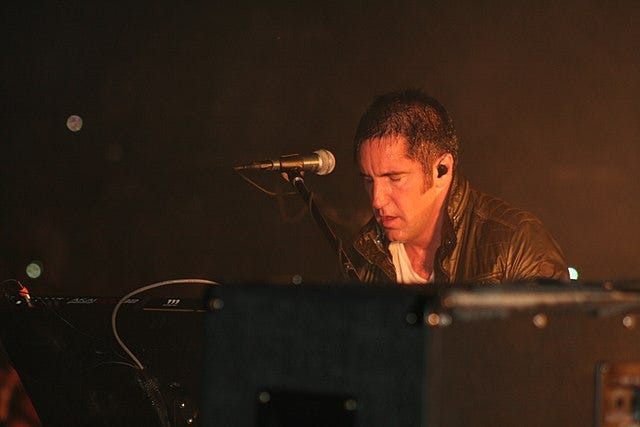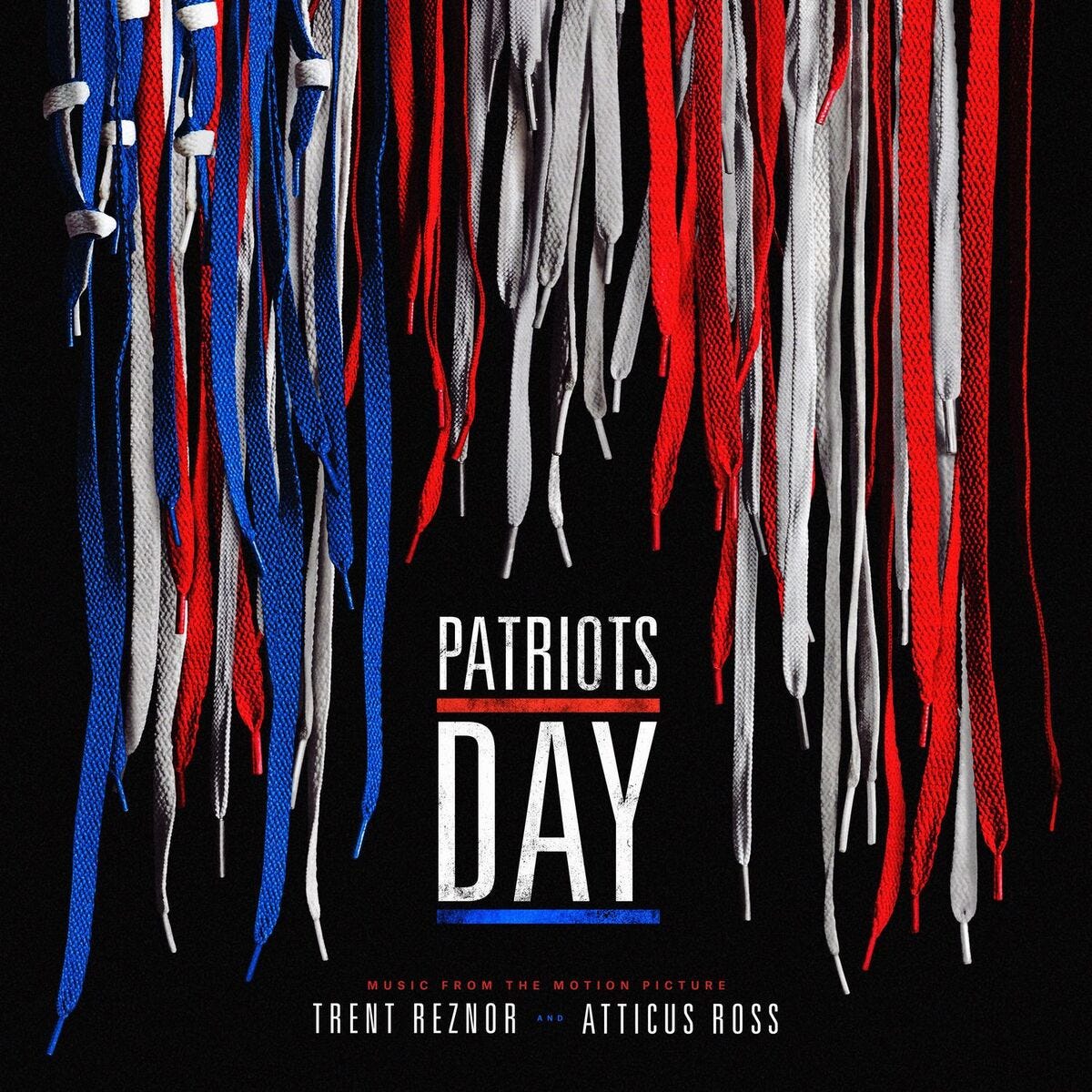Down the spiral with author Adam Steiner
On the Nine Inch Nails legacy and the best Reznor/Ross soundtracks
There are few better ways to pass the time than geeking out with a fellow music fan about your mutual appreciation of an artist. This is exactly what I did one afternoon in East London, meeting author Adam Steiner to discuss the indelible legacy of Trent Reznor and Nine Inch Nails.
If you’re not too familiar with Reznor and his output, I published a Guide to Nine Inch Nails last week on the YouTube channel (an entire hour of it, mind you, so grab yourself some sustenance before you embark on a viewing).
A fair chunk of time went into the research of that video, which admittedly pales in comparison to the work Adam did for Into The Never: Nine Inch Nails and the Creation of ‘The Downward Spiral’. Over more than 250 pages, he unpacks the context surrounding the 1994 record and meticulously maps the references and themes woven through every track.
It’s an impressive read, one that will take you further down the spiral than any hour-long video could (you can grab a copy here).
Sitting down with my coffee, I wondered aloud how Adam came to be the scholar of The Downward Spiral – a title he laughed at, but one he was happy to accept.
As it turns out, we have an early-2000s edition of a now-dead music publication to thank, not to mention the curiosities of a teenager keen to discover something new.
“I was a big fan of Q magazine, God rest its soul, because it was so all encompassing. They looked at everything, it was really genreless. Q had this great feature of the 50 heaviest albums of all time – in there you had Swans, Primal Scream’s XTRMNTR, and then there was The Downward Spiral.”
Adam and I had similar school experiences – we were both acutely aware of the musical interests of our peers, but spent much of our time hunched over battered copies of the various music publications still going strong in early-to-mid 2000s Britain.
We were both on the hunt for things we hadn’t yet been exposed to – even if we were still taking part in the rite-of-passage CDR swaps happening across the year group. (Adam remembers Limp Bizkit’s Chocolate Starfish and the Hot Dog Flavored Water and Eminem’s Marshall Mathers LP; I remember Linkin Park’s Meteora and 50 Cent’s The Massacre.)
Reznor’s bruising narrative documented in The Downward Spiral (henceforth referred to as TDS for brevity) is just the right kind of darkness to appeal to impressionable young minds discovering the darker side of music for the first time.
Adam said: “Looking into TDS, sitting parallel to something like The Holy Bible [Manic Street Preachers’ 1994 record], they are both albums about personal torment. It's a big term, but I guess that's a big word for mental health struggles, alienation, depression, and struggles with self worth. A lot of that chimes with teenagers; very self absorbed, sometimes feeling isolated even when they're surrounded by people.
“I was really attracted to the themes on the record and the lyrics, which are relatively straightforward and direct but they're full of that angst, that anger, self-doubt, a lacerating self-inquiry.”
Of course it wasn’t just the themes that attracted a young Adam. It was also the fact that TDS sounded – and still sounds – intense and nasty: “Amazing drum machines, these synth sequences doing crazy arpeggios, and so much distortion, so broken and hostile. You just weren’t getting that in mainstream music.”
All these years later, Adam’s confident that TDS remains Reznor and NIN’s towering achievement: “It’s their most comprehensive artistic statement, it’s the most daring and challenging.”
As fair as ‘artistic statements’ go, the NIN project has churned out a fair few of them since its inception in 1989. A lot of that comes from the set up , which isn’t strictly a band in the traditional sense at all.
Aside from Reznor being the only permanent member until 2016, the music itself has always sounded a bit out of its time. It hasn’t followed trends, and has almost always sounded distinct from the music made around it, perhaps with the exception of With Teeth’s mid-2000s modern rock sound.
“Nine Inch Nails is a machine for making music within”, said Adam. “It’s a slightly highfalutin phrase, but it’s to express that fact that it’s more of a construct. It’s not goth, it’s not industrial, it’s not techno, although in the 90s there was some element of that. It’s not thrash but there are elements of that in there. It’s not pure electronica or ambient, even though Reznor and Ross have gone on to do so much ambient stuff.”
Ultimately, Adam thinks of Reznor as being a “masterful auteur”, someone who has consistently rewritten the course of his musical legacy each time he sets to work on a new project.
“[Reznor is] clearly a very sharp, precise mind that could see almost where things were going and could run with it. His thing was always, ‘how can I change things? How can I twist things?’”
One of the richest (and more recent) facets of the Reznor legacy is his score work with fellow NIN member and longtime collaborator Atticus Ross.
Most people will have heard their soundtrack to The Social Network, which is a drop in the ocean of projects Reznor and Ross have embarked on since 2010 – the soundtrack for HBO’s Watchmen, the Ken Burns documentary The Vietnam War, and Mark Wahlberg’s Patriots Day, the latter of which Adam references in Into The Never.
“The projects that Reznor and Ross choose tend to be really high quality,” he said, “and they put in a lot of momentum where it needs it. They put in a lot of subtle ambience, they put in a lot of distorted, dirty, disruptive things that jar you.”
“[Patriots Day] was him and Ross messing around with tape loops, so it has quite an analogue, rough sound. You have the limited basic tones, maybe a small melody, and it loops and builds and develops.
“It stacks up and keeps constantly changing. They made a really organic sound from an electronic technical process. And who else would think to do that for what is quite a mainstream movie.”
Adam makes a good point – on the face of it, Patriots Day doesn’t exactly seem like the most creative endeavour, not least because the inclusion of Mark Wahlberg in a cast is rarely a mark of cinematic quality.
But Reznor and Ross take the narrative of the Boston bombing and use the film’s themes of time and tension as a through-line of their soundtrack: the time epitomised by the repetition of the loops, and the tension built through all of that sonic stacking.
So what of the future of NIN, and the tantalising prospect of new material via the upcoming soundtrack for Tron: Ares?
“My learned offhand assessment is that it’s a thirst trap”, he joked. “‘You want a Nine Inch Nails album? Here’s this instead!’ It’s like Radiohead setting up a production company and everyone’s excited for a new album, and then nothing. It’s a massive, massive tease.”
Joking aside, like any NIN fan Adam is awaiting this release with intrigue. “It’s a great idea, who better to do it? I really liked the Tron: Legacy soundtrack from Daft Punk, it’s really interesting.”
It’s another late career move that reminds us of how Reznor – and by extension, NIN – will rarely make the expected move.
“He doesn't repeat himself, which gets massive respect because these days people get sharply funnelled. It’s a PR thing, a public image thing, the manager on your shoulder saying ‘we need the Downward Spiral part two’! But you can’t expect to repeat that kind of success, so I really admire Nine Inch Nails for never repeating itself.”
Returning one last time to the album at the heart of his book, Adam reflected on the legacy that puts Nine Inch Nails head and shoulders above their late-’90s and early-2000s peers – many of whom, he argues, haven’t come close to matching their staying power.
“They can hit the kind of feelings and emotions that The Strokes and The White Stripes just couldn’t. ‘Seven Nation Army’? Great, everyone claps along in the stadium. But as a statement of intent or deeper meaning, who gives a fuck?
“Sorry Jack White,” he added.
You can purchase Adam’s book Into The Never: Nine Inch Nails and The Downward Spiral here. He’s also published Darker with the Dawn: Nick Cave’s Songs of Love and Death and Silhouettes and Shadows: The Secret History of David Bowie’s Scary Monsters (And Super Creeps).








